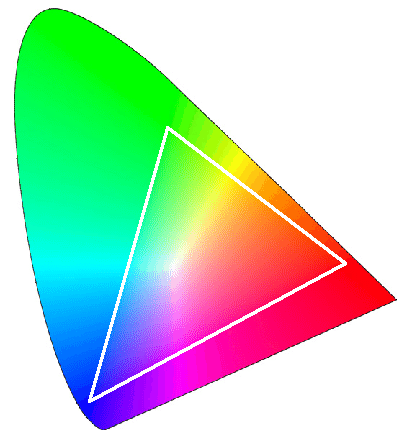- Home
- Photoshop ecosystem
- Discussions
- Re: High saturation blue-greens
- Re: High saturation blue-greens
Copy link to clipboard
Copied
I work with textiles and am working on a project to reproduce near-exact fabric color swatches online. I cannot get RGB/Hex web colors for high saturation blue-greens or green-blues that are found in many fabrics. In fact, the hue zones in between green and blue go very weak (low saturation) in the PS color picker tool. Has anyone else run into this problem also? Do I need to use another system other than HTML colors? Has anyone been able to successfully "grab" high-saturation blue-green/green-blue hues from your photographs to reproduce in a browser? Thanks, Michael
 1 Correct answer
1 Correct answer
If you can't get to that color on screen, it's out of gamut for sRGB. It's outside the sRGB color space and can't be reproduced.
Your display has a gamut, a range of reproducible colors, that is roughly similar to sRGB. There are displays with wider gamut, but these are usually expensive and most people won't have that.
You can work with colors outside sRGB in Photoshop if you use a bigger document color space like Adobe RGB. However, you can't see them on screen. You should also be well experienc
...Explore related tutorials & articles
Copy link to clipboard
Copied
You have to read up on color mangement and how browsers handle it (or don't) plus how web colors are actually rendered. With that in mind you are probably wasting your time, because none of that will bear any influence when someone is viewing your pages on an uncalibrated computer plus the colors may be out of gamut to begin with - there simply is no way to fully capture the reflective and transmissive behavior of many textiles. Their color perception is too dependend on view and light incidence.
Mylenium
Copy link to clipboard
Copied
With that in mind you are probably wasting your time, because none of that will bear any influence when someone is viewing your pages on an uncalibrated computer
This is all the more pertinent considering that meaningful Color Management practically is an impossibility with smart phones and tablets so far.
Copy link to clipboard
Copied
Mylenium wrote
you are probably wasting your time, because none of that will bear any influence when someone is viewing your pages on an uncalibrated computer
That is a meaningless position. Are you personally responsible for everybody else's setups? Of course not. How people choose to view my work is their problem, not mine. They can do it right if they choose to.
As long as I get it right, I've kept my end of the bargain. The correct version is there and available.
Out of gamut is, of course, a different matter.
Copy link to clipboard
Copied
https://forums.adobe.com/people/D+Fosse wrote
Mylenium wrote
you are probably wasting your time, because none of that will bear any influence when someone is viewing your pages on an uncalibrated computer
That is a meaningless position. Are you personally responsible for everybody else's setups? Of course not. How people choose to view my work is their problem, not mine. They can do it right if they choose to.
As long as I get it right, I've kept my end of the bargain. The correct version is there and available.
Out of gamut is, of course, a different matter.
Are you not effectively agreeing to Mylenium’s post?
You do it right, everybody else’s display is their own responsibility and therefore it is »wasting your time« to worry about it?
Copy link to clipboard
Copied
If there is an help at all: have you ever seen another graphic on a web site with the colours you want? It might be an illusion caused by context, but otherwise you can save and sample that graphic. If you've never seen a graphic with the colour you want, it's a pretty strong indication. Display of colour products on the web is a nightmare, with a high level of returns, because colours vary wildly.
Copy link to clipboard
Copied
If you can't get to that color on screen, it's out of gamut for sRGB. It's outside the sRGB color space and can't be reproduced.
Your display has a gamut, a range of reproducible colors, that is roughly similar to sRGB. There are displays with wider gamut, but these are usually expensive and most people won't have that.
You can work with colors outside sRGB in Photoshop if you use a bigger document color space like Adobe RGB. However, you can't see them on screen. You should also be well experienced with basic principles of color management to do that, because it has a lot of practical implications you need to be aware of. Otherwise you quickly get into trouble.
This is sRGB. As you can see, the cyan/blue range is where the gamut is most restricted:

Copy link to clipboard
Copied
Well, whose problem it is, is a complicated question. If I want to sell clothes on the web and customers return most of the clothes because to them "the colour is wrong" it becomes my problem. It doesn't have a solution of course, but the problem is not always just for the end user.
Copy link to clipboard
Copied
https://forums.adobe.com/people/Test+Screen+Name wrote
If I want to sell clothes on the web and customers return most of the clothes because to them "the colour is wrong"
From what I hear, clothes are mostly bought and sold on the web these days, and presumably not using calibrated displays. So apparently it's not a huge problem.
Don't forget that if someone's screen is off the map, he or she will see everything that way. The eye and brain's ability to adapt to conditions comes in handy there...
Copy link to clipboard
Copied
1. Turquoise fabric isn't uniformly colored. The reproduction requires
many different shades. The reproduction doesn't require extremely
saturated colors, because textile colors are surface colors and therefore
not narrow-banded (in the spectrum). Examples:
https://www.whitelodgefabric.com/turquoise-fabrics.html
2. Viewing these examples on a calibrated monitor (near sRGB), these
colors are for me sufficiently saturated and in many (other) examples
far beyond "average" acceptance (disputable, of course).
3. Web safe colors are just a subset of RGB colors.
Six Values 0, 51, 102 153, 204, 255 in each channel, which delivers 6*6*6 =216
combinations or simply "colors" if we refer always to sRGB.
No need for this restriction. Monitors near to sRGB should be assumed,
which delivers for values 0,1,...,255 altogether 256*256*256=16.8 millions
of colors.
4. How are the available sRGB colors looking on an actual monitor?
Just show pages 19 – 21 of this doc:
http://docs-hoffmann.de/swatch22112002.pdf
Of course they don't look like the illustration in the horseshoe diagram #3,
because darker and less saturated colors are there not shown.
5. Regarding the fact, that all kind of textiles are already available on-line,
the task is neither useless nor hopeless. It can be expected, that monitors
will be further improved in future.
Of course I acccept opinions like Dag Fosse's #5 or TestScreenName's #6.
6. Other objections, besides lack of calibration, are varying viewing conditions,
not only for the monitor but also for the cloth (metamerism).
That's really a wide field...
7. For professional applications true fabric samples are probably helpful.
https://www.pantone.com/fashion-home-interiors
Best regards --Gernot Hoffmann
Copy link to clipboard
Copied
From your input and others who posted here, I can safely assume there is no better system to work with than RGB colors, correct? ... And there will be limitations with both this RGB color system and the correct calibration of the user's display, true? My objective for reproducing these fabric swatch sets is so that my clients can pull them up on their phones while they are shopping for clothes in a store (physically, not virtually). Phone displays are another limitation, and I believe phone displays have an even greater level of unreliability than tablets or laptops or desktop displays. I will be giving my clients physical swatch sets, but sometimes I may not have a full set due to availability. So, I wanted to supplement with the online swatches. Thanks to all for your input!
Copy link to clipboard
Copied
Some data, good or bad: What is the average return rate for apparel online, and what are best practices to avoid returns? - ... "fashion has a very high return rate. 48 % of e-commerces say that they have a return rate of between 25 and 50 %. "
Think Tank: The Opportunity in Online Returns for Apparel Retailers – WWD " 70 percent of apparel returners said the size or color was wrong, and that was the top reason for returning an apparel item. "
Clothes have an extraordinarily high return rate compared to most things (even before the web) and this must be factored in the price somehow.
Find more inspiration, events, and resources on the new Adobe Community
Explore Now
